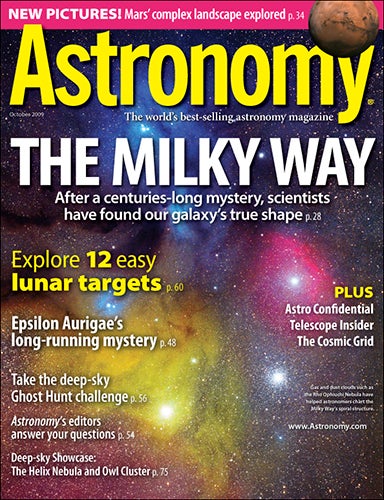
Astronomy Editor David J. Eicher previews the October 2009 issue
WAUKESHA, Wis. — Some 4 centuries ago, Galileo Galilei first realized that the glowing band stretching across our night sky, dubbed the Milky Way, is actually clusters of innumerable stars. More than 300 years later, Edwin Hubble discovered that the Milky Way Galaxy in which we exist is only one of many galaxies in our universe. Since then, scientists have been faced with the challenge of analyzing its structure: When you’re in the maze, it’s much more difficult to understand its form.
Page through parts of the October 2009 Astronomy magazine.
Still, they’ve been able to find a shape. In “How we mapped the Milky Way,” Associate Editor Liz Kruesi explains how researchers combined information from different observation methods to unravel the structure of our galaxy’s spiral arms and central bar.
“Both astronomers’ persistence and detection methods, which have utilized a large portion of the electromagnetic spectrum, were crucial to the breakthrough.” Kruesi says. “By observing different types of radiation — optical, radio, and infrared — researchers could pick out different features of the arms and piece them together for the whole picture.”
Pick up the October issue of Astronomy, on newsstands September 1, to discover the details of the Milky Way’s shape and learn some of the mysteries that still exist about our galaxy.
“Seeking ground truth on Mars”
Currently, three orbiters and two rovers have eyes on the Red Planet, continuously sending back new data and stunning images. In “Seeking ground truth on Mars,” Senior Editor Richard Talcott explores the many insights these five spacecraft have revealed, including weather and climate patterns and Mars’ complex history of water and ice.
“Epsilon Aurigae: Astronomy‘s longest-running mystery show”
At the beginning of August 2009, the bright star Epsilon Aurigae began to dim, something it has been doing every 27 years since observers started noticing the brightness change in 1821. In the next 2 years, it will darken by almost a full magnitude before returning to its normal brilliance. Still, astronomers aren’t sure what’s causing this strange eclipse. In “Epsilon Aurigae: Astronomy’s longest-running mystery show,” Robert Zimmerman explains the current theories about Epsilon Aurigae’s unusual pattern and previews how new technology may soon provide astronomers with answers.
Also in the October 2009 Astronomy
- “Take the Ghost Hunt challenge” — This Halloween season, grab your telescope and scare up these spooky objects.
- “Explore 12 great lunar targets” — Sharpen your observing skills on the Moon’s craters, lava flows, and an elusive letter X.
- “The Sky This Month” — Exclusive pullout star charts will guide you through October’s night sky.
- The October issue of Astronomy also includes Astro News, Beautiful Universe, Bob Berman’s Strange Universe, Glenn Chaple’s Observing Basics, David Levy’s Evening Stars, Stephen James O’Meara’s Secret Sky, Ask Astro, Astro Confidential, Deep-sky Showcase, Telescope Insider, New Products, and The Cosmic Grid.









